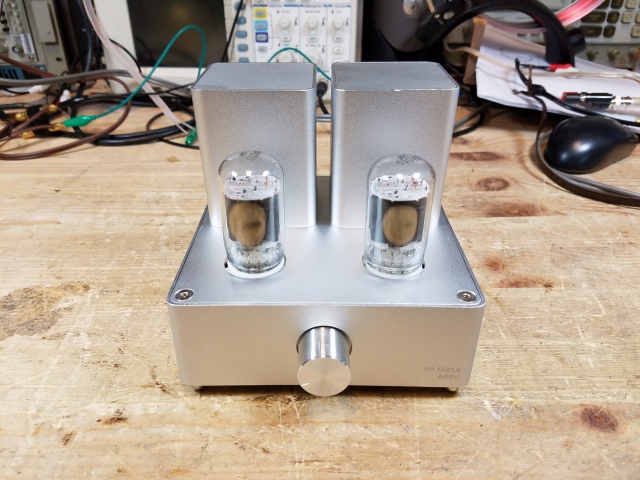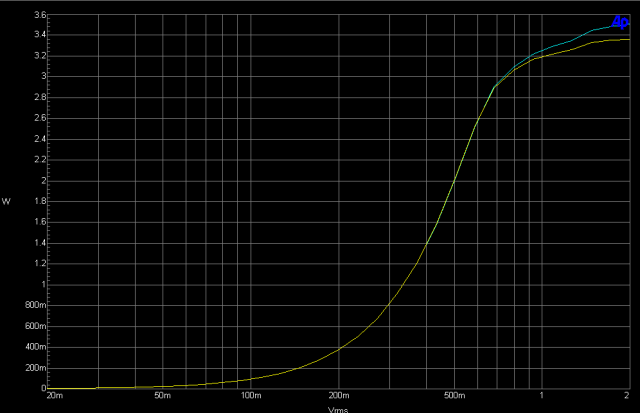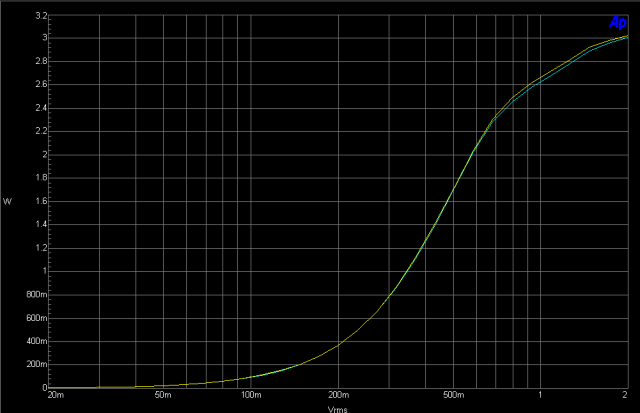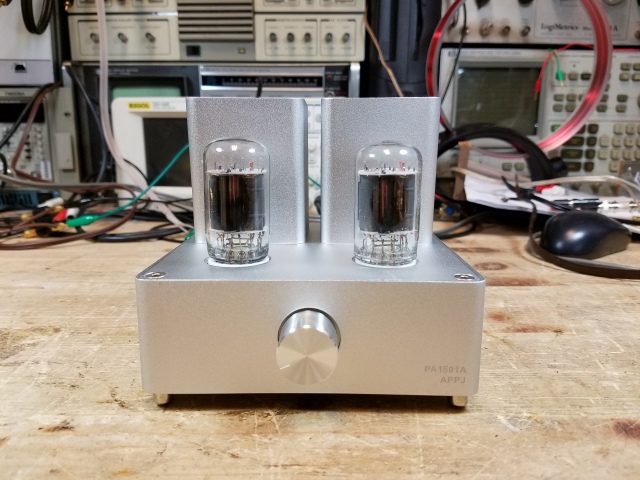I recently picked up an interesting little tube amp via a group buy on Massdrop, the Gemtune APPJ PA1501A stereo tube amplifier. Try saying that three times fast! It’s a cute little single-ended stereo tube amp using a pair of 6AD10 Compactron tubes which have two functional sections, one voltage amplifier pentode used for the amp’s input stage, and a beam power tetrode used for the amp’s output stage that’s fairly similar to a single-ended old school (no suffix) 6L6. The manufacturer suggests it’s good for 3.5W of output power, single-ended, per channel. And it looks good, too! Not bad for under $200.

The 6AD10 Compactrons used in this amp were originally used as integrated audio sections (detector/driver and output) in a number of televisions and combination units towards the very end of the tube era but not many other places, so while they’re not as common of an “odd tube” as something like a 5AQ5, etc. they’re readily available, and they don’t get talked up much for audio use other than in this amp (and rebranded versions thereof) and some sites about homebrewing with junkbox tubes. As such, NOS replacements can be had for as low as $5 if you want to try different brands of tubes and see how they change the sound.

The amp is physically quite small, under 6″ cubed, and has a very minimalist design. Everything is in mid-matte silver with subtle labeling, also available in black. There’s a single volume control on the front sporting a machined metal knob that feels decently weighty, a pair of ceramic 12-pin Compactron sockets, and output transformers hidden inside shrouds with banana plug ports on the rear. The manufacturer names the output transformers as Japanese Z11-EI48 models which I assume is meant to signal quality, although there’s still no substitute for more iron in and output transformer no matter how carefully the laminations are stacked and windings are threaded.
There’s also the input RCA jacks, IEC power input, fuse, and switch. Very minimalist. The banana plug spacing is perfect to accommodate standard separate, or dual banana plug arrangements. With only one input (and a low power rating), this is really meant to be a single-source desktop amp driven from a DAC or high-end sound card.
Glows nicely!
Inside, there’s a switching power supply and an assortment of Nichicon and Rubycon capacitors. There appears to be a solid-state stage ahead of the tubes based on the TO-220 transistors up near the volume control.
Lifting off the top, there’s a shield protecting the output transformers from picking up interference from the switching power supply located below them, and an assortment of passive components supporting the gain stage and power stage of the 6AD10 tubes. There are also a pair of LM431 “Adjustable Precision Zener Shunt Regulator” in an SOT-23 package to provide power regulation.
The specifications were given as follows:
Specifications:
Tube: 6AD10
Power Output: 3.5W+3.5W @ 8 ohms
Frequency Response: 30-40Khz (+-1db)
Input Sensitivity: 500mV
Signal-to-Noise Ratio: -80dB / 3.5W
Residual Noise < 0.5mV AC
Input AC Voltage: 100-250V AC
Power Consumption: 38W
Input Impedance: 10K ohms
Output Impedance: 8/6/4 ohms (Japan Z11-EI48*24 Output Transformers)
Time to see how it stacks up. I used a set of Klipsch RB-4 II desktop speakers, and a set of Ohm Acoustics Model D speakers for sound tests. For test equipment, I used the Keithley 2015P multimeter for some quick checks, the Sencore PA81 Stereo Power Amplifier Analyzer, and the Audio Precision System One. All tests – both listening and performance – were administered after the amplifier had a chance to break in by playing a 1 kHz tone into an 8 Ohm dummy load for approximately 8 hours, then sat overnight, and allowed to warm up for 15 minutes before testing to ensure everything has had a chance to unlimber after manufacturing and shipping.
I’d have to say that I enjoy the sound of the amp well enough. Both the Klipsch and Ohm speakers are quite efficient, and I never felt like it was really straining to give me the volume I wanted, without much distortion. Mid-bass through treble was well defined, but the bass was much more reserved than I expected it to be given the published specifications. The amp itself was very quiet even with the volume turned up at no signal, somewhat surprisingly. Running in Class A certainly helps.
The fit and finish was probably a 7/10. Some of the machined edges were a bit rough, and the machined knob manages to actually be *sharp* in one spot. The volume knob doesn’t rotate perfectly smoothly through it’s travel, it binds slightly in the middle. The transformer covers are a nice touch with the standard-spacing banana plug receptacles on the rear, but it’s also obvious they’re concealing small output transformers. With an output transformer, the more iron you have the better bass you’ll get. Small transformers limit the low-end power available but large, good quality transformers quickly get expensive.
The electrical measurements did put the feeling about the bass into some context. First, the output transformers appear to be designed for an 8 ohm nominal load, as that’s where they delivered the greatest output power. 6- and 4-ohm connections delivered lower amounts of power respectively due to the mismatch but only moderately. At 4 Ohms, the apparent power reduction was around 10%. Both the power output sensitivity measurement, and the frequency response, were somewhat out of bounds however.
Gemtune proposed 3.5W into 8 Ohms with 500 mV sensitivity, in other words, with the volume control turned to maximum applying a 500 mV signal to the input jacks will cause the amplifier to deliver 3.5W into an 8 Ohm load. As shown on the “Sensitivity Into 8 Ohms” my example of the amplifier fell somewhat short of this goal, delivering only 2W at that input level. It took about 1.5V at the input terminals for 3.5W output.
Into 4 Ohms, the amp fared even worse making about 1.7W with 500 mV, rising to 3W at 2V. At those power levels, I’d be worried about damaging something if operated that way long-term. The kink in the sensitivity charts occurs about 700 mV and gives about 3W into 8 ohms or 2.7W into 4 Ohms, above that it tapers off as the output tubes are being pushed to their maximum and more input signal can’t drive them any harder. I wouldn’t recommend driving it harder than 700 mV at full signal, which caps this amp’s effective power to just shy of 3W into an 8 Ohm load and a little lower into a 4 Ohm set of speakers. Due to individual differences in the tubes, the power output starts to diverge at the extremes of the chart. More markedly at 8 Ohms than 4, interestingly enough, likely due to the lower overall power output at 4 Ohms.
The frequency response was given as 30 Hz – 40 kHz +/- 1 dB. I’ll give them “close enough” on the high end (-1 dB just shy of 40 kHz) since that’s well beyond human hearing anyway. The low end was a bit disappointing, though, with the published roll-off being more optimistic than reality proved. The channels diverged by 0.5 dB on the low end, although as the channel separation is less than the flatness specification (0.5 dB < 1 dB) this isn’t something where I’ll give them a negative mark. However, the -1 dB point was located at about 46/55 Hz; at 30 Hz it’s down to -2.3/-2.65 dB and at 20 HZ it’s down to -4/-4.55. This definitely explains why I felt the bass was a bit lacking.
That’s not to say I think the amp is a bad performer. I think it’s a good, starter tube amp. It’s not trying to be anything more than what it is, which is a slightly novel desktop tube amplifier with a sleek and minimalist design that will fit in nearly anywhere. The 6AD10 tube is an interesting touch, and they’re available pretty inexpensively.
Overall, this is a 3/5. It’s value matches the price paid for it, and this type of performance is what you get for that price. A great splurge for a person just getting into audio in high school or college, someone who wants a small tube amp for their desk and wouldn’t mind having someone ask about it, someone who likes oddball tube amps, or who just wants something a little different.




![IMG_20140215_223451[1]](https://tvforfree.files.wordpress.com/2016/08/img_20140215_2234511.jpg?w=640&h=480)





Great review,
What do think about using this amp as the tweeter amplifier in a biamping arrangement? I have 100 dB/W Bastanis Prometheus speakers. I would us something like the Vista Audio Spark a 20W speaker for the 12 inch wide bander (it has no crossover), which goes from 100Hz to 11 KHz and the Gemtune APPJ PA1501A for my tweeter which has a capacitor to limit to frequencies to above 11 KHz. Hopefully with such an efficient tweeter and the Gemtune APPJ PA1501A only having to work above 11 kHz it may last quite a while and not go through many tubes. Do you think it is nice enough / sweet enough in the top end for this purpose?
I might add that the reason I ask is because I also have a Transcendent Sound “Son of Beast” OTL amplifier that sounds fantastic, but I need to use sparingly because it does go through EL509 valves, which are pricey.
Regards,
Ben
Hi. Thanks for the Review, esseccially for your measurements. Did u measure the frequency Response with full power or with 1 W or 0,5 W?
This amp isn’t quite powerful enough for my low sensitivity speakers. Will a preamp help? I was thinking something small like a headphone amp from Schiit with preouts. Thanks
Short answer is no…the input sensitivity on this is sufficient to drive it to max output from a PC or other audio source. The Schiit might give you better audio quality, but won’t help you get more signal. These just only produce a few watts at max power and there’s no way to get more from this amp without some major modifications.
This amp isn’t quite powerful enough for my low sensitivity speakers. Will a preamp help? I was thinking something small like a headphone amp from Schiit with preouts. Thanks
I don’t see how -4dB @ 20Hz is a big deal. It’s actually a good thing that the sub bass frequencies are not eating up a big chunk of the power for a small amp like this.
Thanks for the quick reply, yes I had that backwards, it is an 82uF cap. I’ll try a 450.
Mine used to be completely dark and transparent. After three months it has developed a slight crackling, opened it up and CO2 (the cap just to the right of the rectifier IC1) was bad. The top is swollen. I have a feeling I will be on my own with this one. It is a 28 uf 400V Nichikon, I am in the US with 120 wall power. Anyone think I should just replace with the same cap, or upgrade the cap? Still sounds great just bugs me when I am not playing anything to hear the crackling.
28 uF is a weird value. May be 450V to be safe but that doesn’t sound unreasonable.
Thanks for the great review! I grabbed one of these with a large discount from amazon warehouse deals. I’m thinking of switching the coupling capacitors for some larger value 0.47uF ones to improve the bass response. People have been doing this on the APPJ PA1502A, which uses the same capacitors. I already switched the tubes out for some NOS GE.
How easy is it to take the tubes out? What do I need to do? Thanks for any help.
Rich
Good grafjc diagram 😉
I wasn’t able to get the bottom plate of the amplifier off ….
you have peaked my curiosity ..
The corner screws are meant for a weird bit I didn’t have in any of my various tool sets…it was kind of like Safety Torx but a little different. I found the right ones online, though, and will update with some photos when they arrive from Amazon!
Photos added!